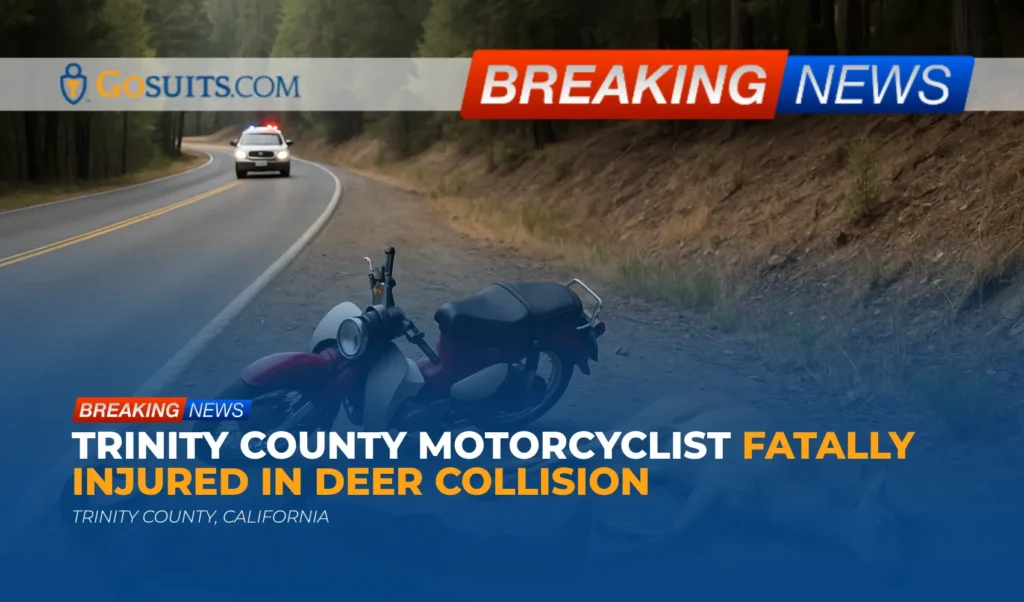A tragic incident occurred Thursday afternoon on State Route 36 in Trinity County, California, resulting in the death of a motorcyclist. According to the California Highway Patrol (CHP), the single-vehicle collision happened near milepost marker 33.8 at approximately 2:17 p.m. The incident involved a motorcycle and a deer.
Details of the Accident
Emergency personnel from multiple agencies, including the CHP, Trinity County Sheriff’s Office, US Forest Service, Cal-Fire, and Cal-Trans, responded to the scene of the crash. Upon arrival, authorities found the motorcycle, identified as a 2019 Honda Super Cub C125, lying on its side on the north dirt and gravel shoulder of the highway.
The rider, David Lindberg, born in 1954, was pronounced dead at the scene. Initial reports indicate that Lindberg was wearing a DOT-approved motorcycle helmet at the time of the collision.
Investigation and Contributing Factors
The CHP has stated that neither driving under the influence (DUI) nor drugs are considered to be factors in the crash. The Trinity County Sheriff’s Office is conducting the coroner’s investigation, while the California Highway Patrol, Trinity River Area, is investigating the circumstances surrounding the incident. Authorities are encouraging anyone with information about the crash to contact the Trinity River CHP Office at (530) 623-3832.
Legal Considerations in Motorcycle Accidents Involving Animals
While the immediate focus is on the tragic loss of life and the ongoing investigation, this incident also raises important legal considerations from a personal injury perspective. Accidents involving motorcycles and animals, particularly deer, can present complex legal challenges.
In California, as in many states, drivers have a responsibility to exercise reasonable care while operating a vehicle. This includes being attentive to the road and surroundings, maintaining a safe speed, and taking appropriate action to avoid hazards. However, collisions with animals are often unpredictable and unavoidable.
Determining liability in these cases can be challenging. Typically, negligence must be established to pursue a personal injury claim. Negligence occurs when a person or entity fails to exercise the level of care that a reasonably prudent person would exercise under similar circumstances. In the context of a motorcycle accident involving an animal, establishing negligence might involve demonstrating that another party was responsible for creating or failing to mitigate the hazard.

Potential Avenues for Investigation and Claims
While it appears this accident was a tragic and unavoidable incident, a thorough investigation is necessary to explore all potential avenues for legal recourse. Here are some of the areas that may be considered:
- Governmental Liability: In some instances, governmental entities responsible for road maintenance and safety may bear some responsibility. For example, if there is evidence that the area was known to be a high-risk area for deer crossings and proper warning signs were not in place, there may be grounds for a claim against the relevant agency. California Government Code section 835, for example, addresses dangerous conditions on public property. However, these cases are often complex and require demonstrating that the agency had notice of the dangerous condition and failed to take reasonable steps to remedy it.
- Insurance Coverage: Even in a single-vehicle accident, insurance coverage may play a role. The motorcyclist’s own insurance policy may provide coverage for medical expenses, property damage, and other losses. Uninsured/underinsured motorist coverage might also be relevant if another party’s negligence contributed to the accident but they lack sufficient insurance coverage.
- Witness Testimony: Gathering witness statements is crucial in reconstructing the events leading up to the accident. Witnesses may have observed factors that contributed to the crash, such as the deer’s behavior or the motorcyclist’s actions.
- Accident Reconstruction: Skilled accident reconstructionists can analyze the physical evidence at the scene, such as skid marks and vehicle damage, to determine the sequence of events and contributing factors. This analysis can be critical in establishing liability and supporting a claim.
- Helmet and Safety Gear: While the report indicates that the motorcyclist was wearing a DOT-approved helmet, the condition and effectiveness of the helmet, along with other safety gear, may be examined as part of the investigation. Even with a helmet, serious injuries can occur in a motorcycle accident.
- Road Conditions: It’s important to assess whether road conditions, such as potholes, gravel, or inadequate lighting, contributed to the accident. If hazardous road conditions played a role, the entity responsible for maintaining the road may bear some liability.
Importance of Legal Consultation
Following a serious motorcycle accident, particularly one involving a fatality, consulting with a seasoned personal injury attorney is crucial. An attorney can conduct a thorough investigation, assess all potential avenues for legal recourse, and guide the victim’s family through the complex legal process. They can also negotiate with insurance companies and represent the family’s interests in court if necessary.
Navigating the aftermath of such a tragic incident can be overwhelming, and a skilled attorney can provide invaluable support and guidance. This includes helping the family understand their rights, gather evidence, and build a strong case.

Commentary from Gosuits Trinity County, California Personal Injury Attorney
This tragic accident highlights the dangers faced by motorcyclists, particularly in areas with significant wildlife populations. While it appears this was an unavoidable collision with a deer, it underscores the importance of vigilance and caution while riding. A comprehensive investigation is necessary to determine all contributing factors and explore any potential avenues for legal recourse for the victim’s family. Gosuits in Trinity County, California, extends its deepest condolences to the family and friends of the deceased.





